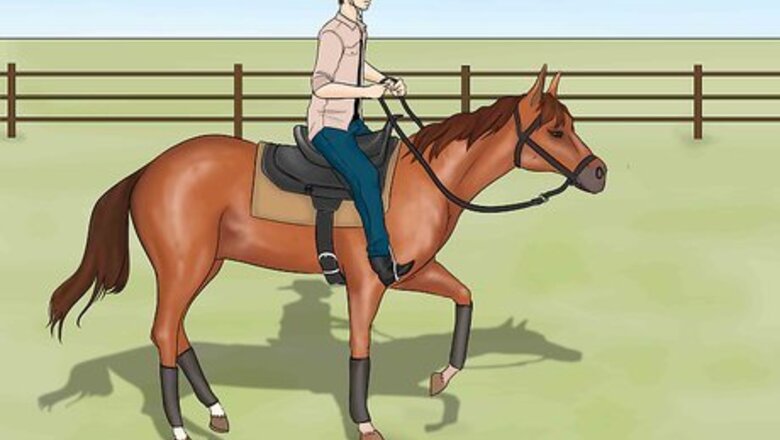
views
Mastering the Prerequisites to Flying Lead Changes
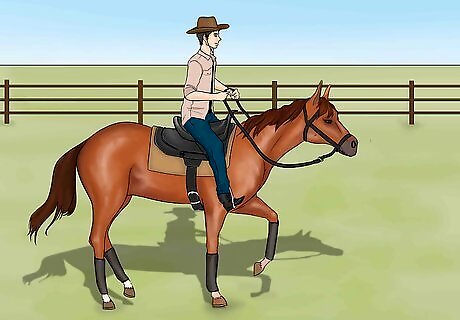
Develop a comfortable, collected canter. A flying lead change happens at a canter, so be sure to practice cantering until you and your horse are very comfortable. Aim for a smooth and controlled canter that follows a steady, 3-beat rhythm. Your horse in the canter should be making big, round, expressive strides and have plenty of lift off the ground so it can successfully change its legs in the air. As you are cantering, use pressure from your outside leg and outside rein to keep your horse going straight. Put tension on the inside rein to flex your horse slightly in the direction of the lead.
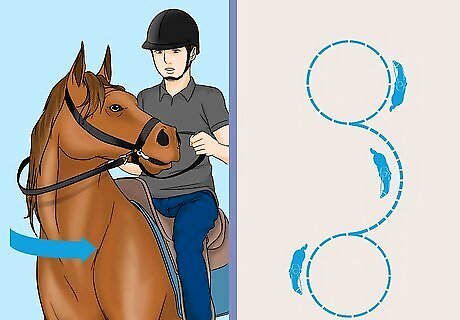
Practice counter cantering. To do this, canter with your horse’s right leg leading. Ride several straight strides on the long side of the arena and then turn in diagonally towards the center. When you’ve come to 50–80 feet (15–24 m) from the rail, bring your horse onto the center line, pressing with your left leg to keep it on a right lead. Turn slightly to the left, keeping your horse bending to the right by pressing your right leg against the girth and your left leg behind it. Your horse should turn towards the left with its haunches towards the rail and continue cantering on the right lead. If your horse breaks into a trot during the turn, start over and give more pressure with your legs on the next turn to keep it cantering. If your horse changes to a left lead in the front as you turn, ask it to come down to a trot by pulling gently back on the reins and try again. Turn your head and look where you are turning to prepare your horse to make a gradual swing in that direction. Practice counter cantering both ways until your horse can do it without tension.
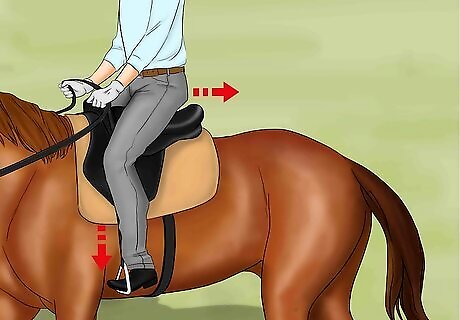
Progress to riding collecting half halts in the canter. In a canter, close your legs around your horse, push down in your seat and close your outside hand for just a moment. This will engage your horse’s hindquarters and encourages a short pause to “sit” back on its hocks. Try riding 3 collecting half halts in a row in the canter. Then, go forward for several strides and ask for 3 collected half halts again.
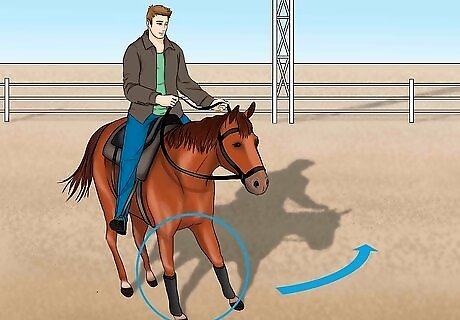
Master simple lead changes. To do this, start by cantering around the arena with your horse leading with its left leg and your right leg facing the outside of the arena. Pull back on the reins to ask your horse to transition down into a trot. After 1-3 strides, press your left leg into your horse at the girth while keeping your right leg against its body just behind the girth to keep it going straight ahead to encourage it to switch to leading with its right leg. Use the inside rein to flex it to the left, in the direction of the new lead. When it switches, bring it back to a canter and repeat the process on the other side. To help you follow the gait change with your hips without losing your balance, keep your core engaged and close your fingers tightly on the outside rein when you ask your horse to come down to a trot. You can also progress to making a lead change from canter to a walk and then back to canter. It helps to slow down the canter with a few collecting half halts before you pull back on the reins to ask your horse to transition to a walk.
Performing a Flying Lead Change
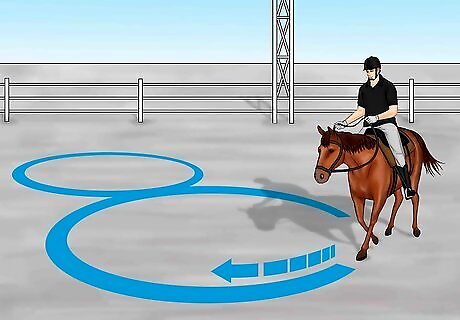
Begin by riding a 10 m (33 ft) figure-eight. Bring your horse to a collected canter and ride in a figure-eight shape in the arena. Do some simple lead changes in the middle of the figure eight to warm up before you attempt the flying lead change.
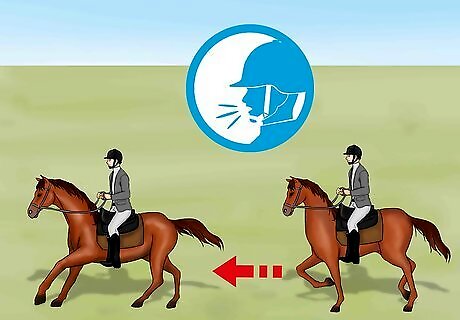
Give the cue to change when your horse’s leading leg is coming forward. Even though the lead change happens when all four of your horse’s legs are suspending in the air, give the cue early, just as you see the leading leg coming forward. This will give your horse time to process and carry out your request. Practice the timing of the aids by watching when your horse’s inside front leg comes forward in a walk. Each time you see it, say “now,” out loud to yourself. Try the same technique in the canter.
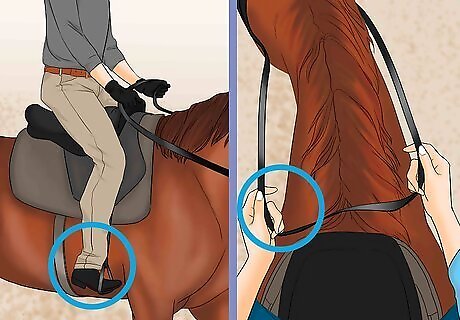
Apply pressure with your right leg and release the tension on the left rein. Bring your horse to a canter on the left lead. Push your right seat bone forward towards your horse’s right ear. You should feel your horse moving a bit to the left.
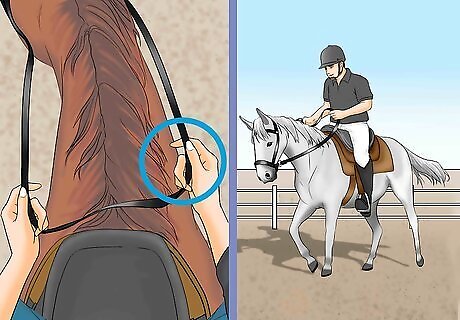
Release the pressure on the right and apply pressure behind the girl with the left leg. Strike firmly and swiftly just behind the girth on the left side. Loosen up on the right rein to give more space for the new inside front leg to come forward. Don’t hold back with the left leg. This part of the cue should be very quick to get your horse to change.
Correcting Mistakes

Help your horse relax before trying lead changes. If your horse feels a little tense, pull back on the reins a bit to bring it down to a trot. Stroke it occasionally on the neck. Speak in a low, calm voice and continue riding around the arena in this way until it is more relaxed. Even if the trot is a bit more lively than you want, don’t pull back on the reins. It’s important that your horse is relaxed and calm when you are practicing lead changes. It doesn’t really matter what you say to your horse as long as it hears your calm, comforting tone. You could say something that would relax both of you, like “You’re going a bit faster than I’d like, but we’re just going to just keep making big circles and not worry about it. I’ll take slow, rhythmic breaths and keep my arms and hands relaxed. I’m just waiting for you to relax, too.”

Canter over a small obstacle before the change to improve the timing. Put a log or other small obstacle in the arena. Canter over the log and apply the leg cues for the lead change as your horse hops over it. This can help incite your horse to change the lead and will help you get the timing right. You can also jump over a low bush if you are riding outside of the arena.
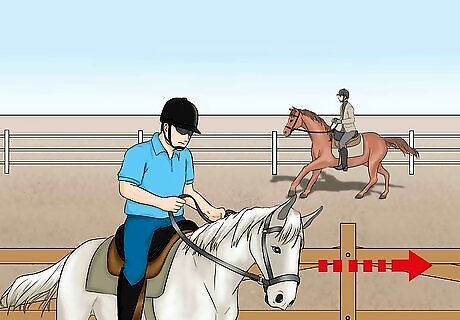
Continue straight after a lead change to prevent your horse from anticipating. If your horse is often anticipating the flying lead change, try to keep it going straight for a few strides after you make the change. If it is allowed to lean, it may start to anticipate and change leads before you ask it to.

Reprogram a horse that doesn’t like lead changes by riding in a serpentine. Go into a right lead canter down the long side of the arena. Keep gentle contact with both legs, but guide it away from the rail with some outside leg pressure and a light pull with the inside rein. Ride a few strides, and then use subtle left-leg and right-rein pressure to bring it back towards the rail. When it’s comfortable with this movement, then go on to ask for the flying lead change. Practice the serpentine on both sides, at least 4 times on each side. This exercise works really well if your horse gets nervous or fussy when you come off the rail towards the middle of your figure-eight because it thinks you are going to ask for a lead change.




















Comments
0 comment